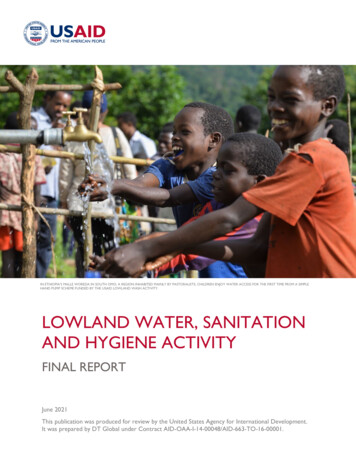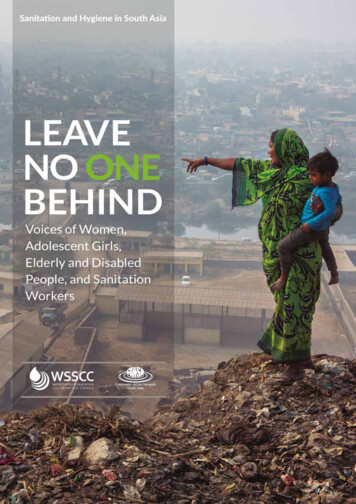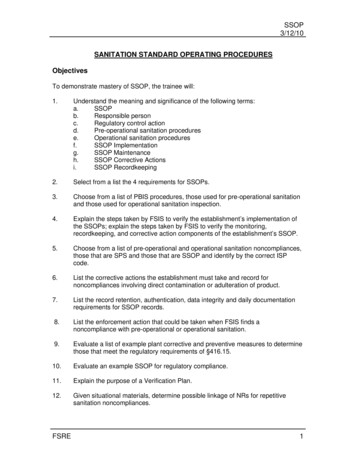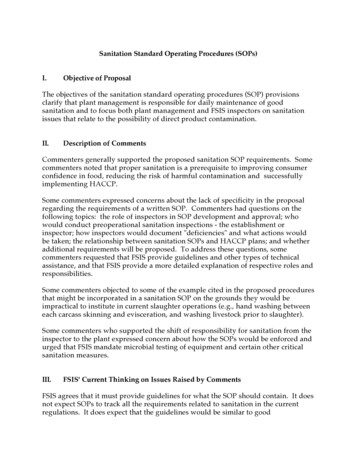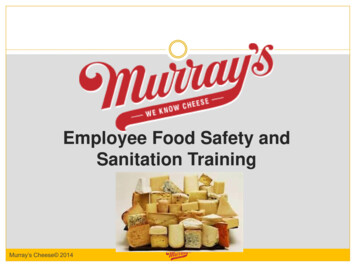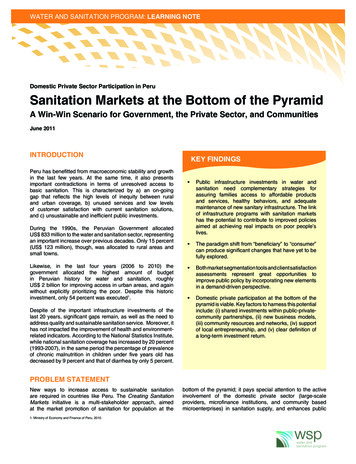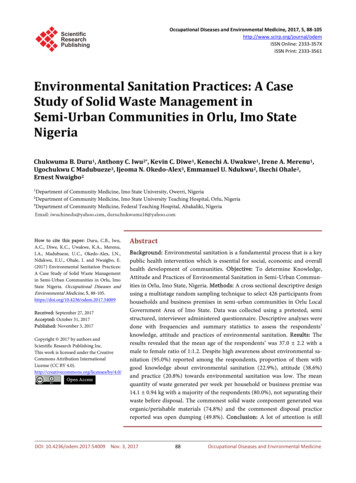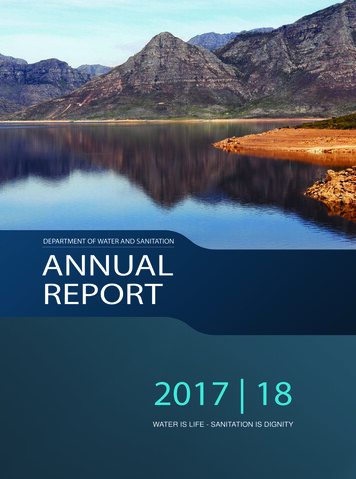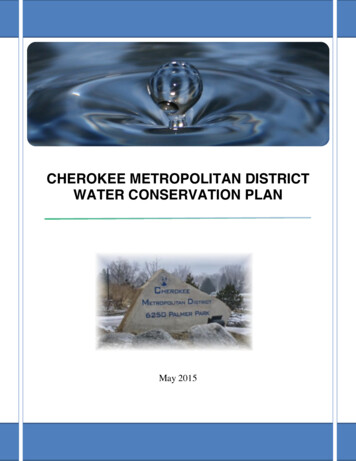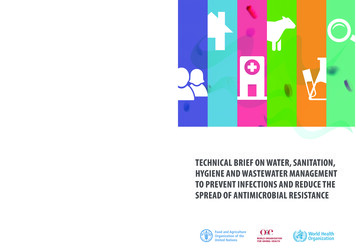
Transcription
Improvements in water sanitation and hygiene (WASH) and wastewater management in all sectors are critical elements of preventing infectionsand reducing the spread of antimicrobial resistance (AMR) as identified in the Global Action Plan to combat AMR. Yet, at present, WASH andwastewater management actors and improvement actions are under-represented in AMR multi-stakeholder platforms and national action plans(NAPs).This technical brief provides a summary of evidence and the co-benefits rationale for WASH and wastewater management actions within NAPsas well as in sector specific policy to combat AMR.Evidence and actions are presented in the domains of:Coordination andleadershipHouseholds andcommunitiesHealth carefacilitiesAnimal and plantproductionManufacturing ofantimicrobialsSurveillance andreserarchTECHNICAL BRIEF ON WATER, SANITATION,HYGIENE AND WASTEWATER MANAGEMENTTO PREVENT INFECTIONS AND REDUCE THESPREAD OF ANTIMICROBIAL RESISTANCEWorld Organisation for Animal Health (OIE)12, rue de Prony75017 ParisFranceWebsite: www.oie.int/ISBN 978-92-95115-63-7
TECHNICAL BRIEF ON WATER, SANITATION,HYGIENE AND WASTEWATER MANAGEMENTTO PREVENT INFECTIONS AND REDUCE THESPREAD OF ANTIMICROBIAL RESISTANCEPublished bythe Food and Agriculture Organization of the United Nationsandthe World Organisation for Animal Healthandthe World Health Organization
Technical brief on water, sanitation, hygiene and wastewater management to prevent infections and reduce the spread of antimicrobial resistance World Health Organization (WHO), Food and Agriculture Organization of the United Nations (FAO) and World Organisation for Animal Health (OIE), 2020ISBN (WHO) 978-92-4-000641-6 (electronic version)ISBN (WHO) 978-92-4-000642-3 (print version)ISBN (FAO) 978-92-5-132641-1ISBN (OIE) 978-92-95115-63-7All rights reserved. WHO, FAO and OIE encourage the reproduction and dissemination of material in this information product. Any proposed reproduction or dissemination for noncommercial purposes will be authorized free of charge upon request, provided the source is fully acknowledged. Any proposed reproduction or dissemination for resale or othercommercial purposes, including educational purposes, is prohibited without the prior written permission of the copyright holders, and may incur fees.Requests for permission to reproduce or translate WHO publications – whether for sale or for non-commercial distribution – should be addressed to WHO Press through the WHOweb site http://www.who.int/about/licensing/copyright form/en/index.html.The designations employed and the presentation of material in this publication do not imply the expression of any opinion whatsoever on the part of the World Health Organization(WHO), the Food and Agriculture Organization of the United Nations (FAO) or of the World Organisation for Animal Health (OIE) concerning the legal status of any country, territory,city or area or of its authorities, or concerning the delimitation of its frontiers or boundaries. Dotted and dashed lines on maps represent approximate border lines for which theremay not yet be full agreement.The mention of specific companies or products of manufacturers, whether or not these have been patented, does not imply that these are or have been endorsed or recommendedby WHO, FAO and OIE in preference to others of a similar nature that are not mentioned. The published material is being distributed without warranty of any kind either expressed orimplied. The responsibility for the interpretation and use of the material lies with the reader. In no event shall WHO, FAO and OIE be liable for damages arising from its use. The viewsexpressed herein are those of the authors and do not necessarily represent those of WHO, FAO, OIE.Publications of the World Health Organization are available on the WHO web site www.who.int or can be purchased from WHO Press, World Health Organization, 20 Avenue Appia,1211 Geneva 27, Switzerland. Tel.: 41 22 791 3264; fax: 41 22 791 4857; e-mail: bookorders@who.int.FAO information products are available on the FAO website www.fao.org/publications and can be purchased through Publications-sales@fao.org.Publications of the World Organisation for Animal Health are available either on the OIE web site www.oie.int or can be purchased through the OIE online bookshop www.oie.int/boutique.Design and layout by L’IV Com Sàrl
TECHNICAL BRIEF ON WATER, SANITATION, HYGIENE AND WASTEWATER MANAGEMENT TO PREVENT INFECTIONS AND REDUCE THE SPREAD OF ANTIMICROBIAL RESISTANCEContentsAcknowledgements. . . . . . . . . . . . . . . . . . . . . . . . . . . . . . . . . . . . . . . . . . . . . . . . . . . . . . . . . . . . . . . . . . . . . . . . . . . . . . . . . . . . ivAcronyms. . . . . . . . . . . . . . . . . . . . . . . . . . . . . . . . . . . . . . . . . . . . . . . . . . . . . . . . . . . . . . . . . . . . . . . . . . . . . . . . . . . . . . . . . . . . . vTackling AMR by including WASH and wastewater management in national policies and plans. . . . . . . . . . . . . . . . . . . . . . . . . 1WASH in the global context of antimicrobial resistance. . . . . . . . . . . . . . . . . . . . . . . . . . . . . . . . . . . . . . . . . . . . . . . . . . . . . . . . . 2How does WASH and wastewater contribute to antimicrobial resistance?. . . . . . . . . . . . . . . . . . . . . . . . . . . . . . . . . . . . . . . . . . 3Global status of WASH and wastewater management. . . . . . . . . . . . . . . . . . . . . . . . . . . . . . . . . . . . . . . . . . . . . . . . . . . . . . . . . . 6Action areasAction area 1: Coordination and leadership. . . . . . . . . . . . . . . . . . . . . . . . . . . . . . . . . . . . . . . . . . . . . . . . . . . . . . . . . . . . . . . . 8Action area 2: Households and communities . . . . . . . . . . . . . . . . . . . . . . . . . . . . . . . . . . . . . . . . . . . . . . . . . . . . . . . . . . . . . . 10Action area 3: Health care facilities. . . . . . . . . . . . . . . . . . . . . . . . . . . . . . . . . . . . . . . . . . . . . . . . . . . . . . . . . . . . . . . . . . . . . . 12Action area 4: Animal and plant production. . . . . . . . . . . . . . . . . . . . . . . . . . . . . . . . . . . . . . . . . . . . . . . . . . . . . . . . . . . . . . . 14Action area 5: Manufacturing of antimicrobials. . . . . . . . . . . . . . . . . . . . . . . . . . . . . . . . . . . . . . . . . . . . . . . . . . . . . . . . . . . . 16Action area 6: Surveillance and research. . . . . . . . . . . . . . . . . . . . . . . . . . . . . . . . . . . . . . . . . . . . . . . . . . . . . . . . . . . . . . . . . . 18References. . . . . . . . . . . . . . . . . . . . . . . . . . . . . . . . . . . . . . . . . . . . . . . . . . . . . . . . . . . . . . . . . . . . . . . . . . . . . . . . . . . . . . . . . . . 20iii
AcknowledgementsWHO, FAO and OIE gratefully acknowledge financial and technical support from the Norwegian Agency for Development Cooperation(NORAD), the Fleming Fund and the United Kingdom Department for International Development (DFID) for the development of thisbriefing note.Lead authors and reviewers:Kate Medlicott, Astrid Wester, Bruce Gordon, Margaret Montgomery, Elisabeth Tayler (WHO, Switzerland); David Sutherland (WHO, SouthEast Asia Region); Oliver Schmoll (WHO Regional Office for Europe, Germany);Marlos De Souza, Sasha Koo-Oshima (FAO, Italy); Katinka DaBalogh (FAO, Thailand);Jorge Pinto Ferreira, Elisabeth Erlacher-Vindel (OIE, France);Helen Clayton (Directorate-General for Environment, European Commission, Belgium); David Graham (Newcastle University, UK), DGJoakim Larsson (University of Gothenburg, Sweden); Gertjan Medema (KWR Watercycle Research Institute); Ana Maria Roda de Husman,Heike Schmitt (National Institute for Public Health (RIVM), Netherlands); Min Yang, Yu Zhang, (Research Center for Eco-EnvironmentalSciences Chinese Academy of Sciences (RCEES), China).Contributors:Antoine Andremont (University Paris-Diderot medical school, France); Nicholas Ashbolt (Southern Cross University, Lismore, Australia andUniversity of Alberta, Canada); Thomas Berendonk (Technical University of Dresden, Germany); Laura Boczek (Environment ProtectionAgency, USA); Joe Brown (Georgia Institute of Technology, USA); Joanna Esteves-Mills (London School of Hygiene and Tropical Medicine,UK); Karina Yew-Hoong Gin (National University of Singapore); Anais Goulas (Laboratoire de bactériologie, Hôpital Bichat-Claude Bernard,France); Arabella Hayter (WHO, Switzerland); Fleur Hierink (National Institute for Public Health (RIVM), Netherlands); Luc Hornstra (KWRWatercycle Research Institute, Netherlands); Paul Hunter (University of East Anglia, UK); Imke Leenen (Foundation for Applied WaterResearch STOWA, Netherlands); Jeffery Lejeune (FAO, Italy); Teresa Lettieri (European Commission, Joint Research Centre, Italy); Karl G.Linden (University of Colorado, Boulder, USA); Stanley Liphadzi (Water Research Centre, South Africa); Jean Francois Loret (Suez, France);Guy Mbayo (WHO Regional Office for Africa, Congo); Bert Palsma (Foundation for Applied Water Research STOWA, Netherlands); Payden(Regional Office for South-East Asia, India), Amy Pruden (Virginia Tech, USA); Mengying Ren (ReAct, Uppsala University, Sweden); CorneliaRodolph (European Commission, Belgium); Daisuke Sano (Tohoku University, Japan); Marc Sprenger (WHO, Switzerland); Claudia Stange(TZW Technologiezentrum Wasser, Germany); Mark D. Sobsey (University of North Carolina, USA); Ashok J Tamhankar (RD Gardi MedicalCollege, India); Huw Taylor (University of Brighton, UK); Jordi Torren Edo (European Medicines Agency, UK); Samuel Vilchez (Center ofInfectious Diseases, School of Medicine, National Autonomous University of Nicaragua, León-Nicaragua); Jan Peter van der Hoek (Waternet,Netherlands); Caroline Whalley (European Environment Agency, Denmark).iv
TECHNICAL BRIEF ON WATER, SANITATION, HYGIENE AND WASTEWATER MANAGEMENT TO PREVENT INFECTIONS AND REDUCE THE SPREAD OF ANTIMICROBIAL imicrobial resistanceActive pharmaceutical ingredientAntibiotic resistant bacteriaAntibiotic resistant genesConcentrated animal feeding operationsDisability adjusted life yearExtended spectrum beta lactamaseFood and Agriculture Organization of the United NationsGlobal Action PlanGlobal Analysis and Assessment of Sanitation and Drinking-waterGlobal Antimicrobial Resistance Surveillance SystemGood Manufacturing PracticeHealth care facilityHealth care associated infectionInfection prevention and controlNational action plan for AMRWorld Organisation for Animal HealthSustainable Development GoalUnited Nations Environment ProgrammeUnited Nations Children’s FundWater, sanitation and hygieneWorld Health Organizationv
TECHNICAL BRIEF ON WATER, SANITATION, HYGIENE AND WASTEWATER MANAGEMENT TO PREVENT INFECTIONS AND REDUCE THE SPREAD OF ANTIMICROBIAL RESISTANCETackling AMR by including WASH and wastewatermanagement in national policies and plansThis technical brief provides information to inform water, sanitation and hygiene (WASH) and wastewater elements within multi-sectoralantimicrobial resistance (AMR) national action plans (NAPs). It includes a summary of evidence and the co-benefits rationale for actionin each sector and presents a menu of actions for consideration and refinement in each country context. The technical brief also identifiessector specific policy options and additional information, including knowledge gaps and research needs, as well as additional technicalresources to support planning and implementation.Where evidence is weak or lacking, actions proposed are cost-effective measures with wider co-benefits for health that plausiblycontribute to combatting AMR.The most relevant actions for any given country will depend on: the status of existing WASH and wastewater services in communities and health care facilities, patterns and intensity of animal and plant production, whether the country manufactures antimicrobials or procures them from abroad, and patterns of antimicrobial use in humans, animals and plants.However, it is likely that in all countries some action is possible and needed in all sectors (Figure 1) regardless of which one can do mostto prevent unnecessary use of antimicrobials and/or the spread of AMR.Action Area 1: Coordination and leadershipEnsure WASH and wastewater management is included in national AMR policies and plans and promote action in all sectorsAction Area 2:Households andcommunitiesEnsure universal access to safelymanaged water and sanitationservices and increase wastewaterand sludge treatment and safereuse in accordance with SDG6Action Area 3:Health care facilitiesEnsure universal access to safewater supply and sanitation,proper hygiene practices andhealth care waste managementin health care facilities to supportinfection prevention and controlAction Area 4:Animal and plantproductionAction Area 5:Manufacturing ofantimicrobialsImprove hygiene and wastewaterand sludge management in foodproductionReduce release ofantimicrobials and ARGs intowaterways from antimicrobialmanufacturingAction Area 6: Surveillance and researchAdvance knowledge on WASH and wastewater drivers of AMR though a One Health lens to inform risk-based prioritiesFigure 1: Actions areas for coordinated multi-sectoral action on WASH and AMR1
WASH in the global context of antimicrobialresistanceThe world is facing high rates of AMR. The pipeline of new antimicrobials has all but dried up, and urgent solutions to tackle AMR aresought from a wide range of stakeholders such as policymakers, engineers and scientists, health care professionals, veterinarians, farmers,donors, non-governmental organizations, and private citizens and corporations. Everyone has a role to play.Low- and middle-income countries bear a greater burden of infectious disease and with limited resources will be most adversely affectedby AMR. However, multidrug-resistant bacteria are carried in the intestinal tract of people and animals around the world, which meansuntreatable symptomatic infections are challenging health care systems everywhere, rendering antimicrobials less effective. As therecent COVID-19 pandemic has shown, global solutions are needed to address global public health challenges and the role of infectionprevention in communities and health facilities is more important than ever.The response to the AMR crisis has been spearheaded through the One Health AMR Global Action Plan (GAP) (1), developed by theWorld Health Organization (WHO) in close collaboration with the Food and Agriculture Organization of the United Nations (FAO) andthe World Organisation for Animal Health (OIE), and formally endorsed by the three organizations’ membership and the United NationsGeneral Assembly Political Declaration at the high-level meeting of the General Assembly on AMR in 2016. The Tripartite organizations,were mandated to support the development and implementation of NAPs and AMR activities at the national, regional and globallevels in collaboration with regional and multilateral development banks, relevant United Nations agencies, particularly United NationsEnvironment Programme (UNEP), and intergovernmental organizations as well as civil society and relevant multi-sectoral stakeholders.A central task is to support the development and implementation of national policies and actions within all sectors to combat AMR atnational, regional and global levels. WASH and wastewater management contribute across all five objectives of the Global Action Planbut contribute most significantly under Objective 3 on reducing incidence of infections (Box 1).Most countries have developed and are periodically revising their AMR NAPs. However, the important roles of WASH and wastewatermanagement is often not addressed, or the actions selected may not be adequately informed by evidence and tailored to nationalcontexts, or lack integration with existing WASH activities. Science-informed actions within AMR NAPs and sectors policy and plansfor improving WASH and wastewater are critical because water, and potentially soil, may be major modes for AMR development andspread – especially in places with inadequate WASH. Plausible causal pathways and growing evidence suggests that effective WASH andwastewater management will reduce risks posed to human, animal and plant health by AMR.WASH and wastewater management within this briefing covers households and communities, health care facilities, animal and plantproduction, and antimicrobial manufacturing including waste management for unused medicines in each setting.Box 1: Five Objectives of the Global Action Plan on Antimicrobial Resistance1: Improve awareness and understanding of antimicrobial resistance through effective communication, education and training2: Strengthen the knowledge and evidence base through surveillance and research3: Reduce the incidence of infection through effective sanitation, hygiene and infection prevention measures4: Optimize the use of antimicrobial medicines in human and animal health5: Develop the economic case for sustainable investment that takes account of the needs of all countries, and increaseinvestment in new medicines, diagnostic tools, vaccines and other interventions2
TECHNICAL BRIEF ON WATER, SANITATION, HYGIENE AND WASTEWATER MANAGEMENT TO PREVENT INFECTIONS AND REDUCE THE SPREAD OF ANTIMICROBIAL RESISTANCEHow does WASH and wastewater contribute toantimicrobial resistance?AMR refers to microorganisms (such as bacteria, fungi, viruses, and parasites) that can become resistant to antimicrobials through avariety of mechanisms, such as mutation or genetic exchange (acquired resistance). This can occur in microorganisms in the body ofhuman or animal hosts, but also in environmental settings where the release of excreta and presence of antimicrobial agents and otherpollutants weaken or deplete the main populations of the target bacteria allowing the remaining resistant strains to persist or flourish.In the environment, genetic material (that includes the genes that code for AMR which can also be present in naturally resistant bacteria)can be shared between bacteria under selective pressure from antimicrobials (along with other selecting agents, e.g. herbicides andpesticides), thus spreading AMR attributes across diverse populations of environmental bacteria and pathogens (2).Water, sanitation, hygiene and wastewater factors play a role in the environmental dispersal and transmission of AMR in three main ways:a) Dispersal via water, sludge and manure potentially resulting in the transmission of disease-causing pathogens to humans, animalsand plants increasing the need for treatment with antimicrobial agents (3).Each year hundreds of millions of cases of diarrhoea in humans are treated with antimicrobials. Universal access to WASH could reducethis by 60%.b) Silent transmission of resistant microorganisms with low pathogenicity that only become evident when they infect particularlyvulnerable populations or their genes are transferred to pathogens causing infection.14% of people globally carry E. coli in their faeces that produce extended spectrum beta-lactamase (ESBL) enzymes which provideresistance to antibiotics such as penicillins, cephalosporins, cephamycins, and to some extent carbapenems (4).c) Release of faecal and other pollutants, including antimicrobial compounds into the environment (excreta from use in humansor in terrestrial or aquatic animals or plants; from disposal of unused antimicrobials; or from antimicrobial manufacturing waste andwastewater) may promote resistance by creating conditions favorable to the transfer or emergence of new resistance genes.Up to 80% of the antimicrobial dose administered can be excreted as the active compound or metabolites depending on the classof antimicrobial and how it is used, and wastewater treatment is often insufficient or not possible. Similarly, antimicrobials in waterdownstream of some antimicrobial manufacturing sites have been found at concentrations higher than in the blood of patients takingmedicines (5).Natural AMR is common among environmental bacteria, including in pristine locations relatively untouched by modern anthropogenicactivities, such as caves, permafrost, and glaciers. However, use of antimicrobial agents such as antibiotics in humans, terrestrial andaquatic animals and companion animals and plants has been associated with the evolution and amplification of antimicrobial resistantpathogens and the antimicrobial resistance genes (ARGs) that they carry. Anthropogenic activities are increasing the importance of theenvironment as a pathway for AMR human exposure. For example, human consumption of antimicrobials can result in antimicrobialresistant pathogens and ARGs being discharged to waterways via open defecation, raw and treated sewage, and liquid effluent from septictanks and pit toilets. Wastewater discharges from sites where use of antimicrobials can be high, such as hospitals, intensive livestockfarms and aquaculture systems are likely to contain particularly elevated concentrations of antimicrobials, antimicrobial resistant bacteria(ARB) and ARGs which might influence AMR spread depending on dilution in the receiving water.Similarly, the use of antimicrobials in terrestrial and aquatic animals and plants can also contribute to the spread of antimicrobialcompounds and their metabolites and clinically-relevant ARGs to waterways via point source pollution (e.g. discharge from feedlots oraquaculture ponds) or diffuse pollution (e.g. manure-treated fields) (Figure 2).3
Manufacturing ofantimicrobialsAnimal and sHouseholds and dwaterHealthcarefacilitiesSource: Adapted from Drivers, dynamics and epidemiology ofantimicrobial resistance in animal production (FAO, 2016)Figure 2: Water, sanitation, hygiene and wastewatertreatment influences on antimicrobial resistanceTreatment of wastewater will always be needed to reduce levels of ARBs, ARGs and antimicrobial compounds and their metabolites releasedto the environment as a result of use in humans and some animals. However, wastewater treatment, depending upon how advanced it is,may not be able to reduce AM concentrations in effluent to levels that remove the risk of promoting AMR acquisition and persistence in theenvironment. Furthermore, excreta from most terrestrial and aquatic animals are generally not treated but collection and manure managementmight have a negative impact on survival of pathogens and stability of antimicrobials. This means that antimicrobials, ARB and ARGs may beapplied to soils through manure and added to marine and freshwater from aquaculture systems.Antimicrobials applied to plants inevitably also enter the environment. Therefore, measures to reduce the level of environmental pollutionneed to be taken as far as possible at source by avoiding misuse and overuse of antimicrobials and other selecting agents (6, 7) in allsectors. It is important to note that even with the responsible and prudent use of antimicrobials, some active antimicrobial compoundsand their metabolites will still reach the environment, although in lower amounts than when antimicrobials are misused and overused.Exposure to AMR pathogens may occur when humans come into contact with contaminated water downstream of point or diffusesources. For example, consumption of contaminated drinking water, recreational water use, or contact with of contaminated water,including as aerosols during irrigation, toilet flushing, or industrial processes (e.g. cooling), may all serve as possible routes of exposureto AMR microorganisms and other pathogens. The direct use of inadequately treated wastewater could also be a contributory factor.Consumption of food products contaminated by resistant pathogens or containing antimicrobial residues can also facilitate the spreadof AMR from animal and plant sources. Attributing the weighted cause of AMR development to particular factors, such as those directlylinked with human use versus animal or plant use versus the environment is difficult, because of overlaps between factors and becauseof insufficient data on the processes involved.4
TECHNICAL BRIEF ON WATER, SANITATION, HYGIENE AND WASTEWATER MANAGEMENT TO PREVENT INFECTIONS AND REDUCE THE SPREAD OF ANTIMICROBIAL RESISTANCEFurther research is needed to better understand the circumstances that promote the development and spread of AMR in the environment,which sources and exposure routes are most relevant in a variety of contexts and how best to prevent the spread and transmission tohumans and animals (8, 9). However, existing drinking-water treatment technologies as well as sanitation improvements, wastewatertreatment, manure management where possible and hygiene interventions are critical barriers to the spread of AMR, similar to theirbarrier function for transmission of other faecally transmitted pathogens. In addition, prevention of infections that would overwise betreated by antimicrobials will limit antimicrobial prescription and use.These WASH and wastewater barriers therefore need to be included in plans and strategies to combat AMR as part of a comprehensiveapproach to addressing multiple drivers of AMR (Figure 3).HumansTerrestrial and aquatic animalsMisuse and overuse of antimicrobials;poor access to quality; affordablemedicines, vaccines and diagnostics;lack of awareness and knowledge;population movementMisuse and overuse of antimicrobials;poor access to quality, affordablemedicines, vaccines and diagnostics;lack of awareness and knowledge;movement of animalsWater, sanitation and hygieneImpact of antimicrobial resistanceLack of access to clean water, sanitationand hygiene; poor infection and diseaseprevention and control in health carefacilities and farmsRisks to foodand feedproduction,businessesand trade;interaction withclimate changeIncreasedmorbidity andmortality inhumans andanimalsEconomicdamage, lossof productivityand increasedhealth careexpendituresFood and feedPoor infection and disease preventionand control; transmission of resistantpathogens in food production, storage,distribution and preparationEnvironmentPlants and cropsDischarge of waste from from healthcare facilities, pharmaceuticalmanufacturing and farmsMisuse and overuse of antimicrobials;poor infection and disease preventionand controlSource: Adapted from Inter-Agency Coordination Group (2019). No time to wait: Securing the future from drug-resistant infections. Report to the SecretaryGeneral of the United Nations.Figure 3: Water, sanitation, hygiene and wastewater contribute as drivers of antimicrobial resistance5
Global status of WASH and wastewater managementWASH in households and communitiesWASH-related diseaseWorldwide, in 2016, 1.9 million deaths and the loss of 123 million disability adjusted life years (DALYs) could havebeen prevented with adequate WASH. The WASH-attributable disease burden amounts to 4.6% of global DALYsand 3.3% of global deaths. The burden of deaths among children under 5 is 13% (10).Almost 830 000 of WASH-related deaths are from diarrhoeal disease.Water supply (11)Globally, at least 2 billion people use a drinking water source contaminated with faeces.71% of the global population (5.3 billion people) used a safely managed drinking-water service – that is, onelocated on premises, available when needed, and free from contamination.90% of the global population (6.8 billion people) used at least a basic service. A basic service is an improveddrinking-water source that can be accessed within 30 minutes (roundtrip).785 million people lack even a basic drinking-water service, including 144 million people who are dependent onsurface water.WASH in health care facilitiesAround 1 in 4 health care facilities lack basic water services – that is, an improved water source located on thepremises. That means 2 billion people are going to health care facilities without an on-site protected source ofwater (12). The proportion may rise during periods of water scarcity.Around 1 in 5 health care facilities have no sanitation service. That means over 1.5 billion people are going tohealth care facilities without toilets (12).Globally, 42% of health care facilities lack hand hygiene facilities at the point of care and 40% do not have systemsto segregate waste (12).Animal and plant productionIt is estimated that globally higher quantities of antimicrobials are used in terrestrial and aquatic animals thanin humans. Use is higher in countries where antimicrobials are used for growth promotion and/or where animalsare raised intensively.Antimicrobials can be excreted virtually unchanged as the parent compound since frequently they are only partiallymetabolized in livestock and poultry (18).If no action is taken, antimicrobial use is predicted to rise by more than 50% from 2015–2030 largely driven byconsumer demand for livestock products (19).Manufacturing of antimicrobialsThe majority of antimicrobials, particularly generics, and active pharmaceutical ingredients (APIs) are manufacturedin India and China (23).Antimicrobial compounds and their metabolites can be found in the wastewaters from manufacturing sites formedicines and APIs. In extreme cases, levels of antimicrobial compounds in water downstream of manufacturingsites have been found at concentrations higher than therapeutic concentrations in the blood of patients takingmedicines (5).6
TECHNICAL BRIEF ON WATER, SANITATION, HYGIENE AND WASTEWATER MANAGEMENT TO PREVENT INFECTIONS AND REDUCE THE SPREAD OF ANTIMICROBIAL RESISTANCESanitation and domestic wastewater treatment (11)Globally 2 billion people still do not have basic sanitation facilities such as private toilets or improved latrines.Of these, 673 million still defecat
Ensure universal access to safe water supply and sanitation, proper hygiene practices and health care waste management in health care facilities to support infection prevention and control Action Area 2: Households and communities Ensure universal access to safely managed water and sanitation services and increase wastewater
